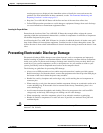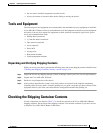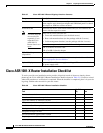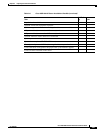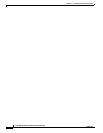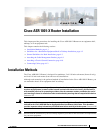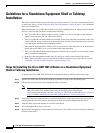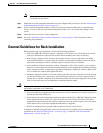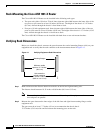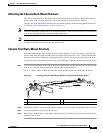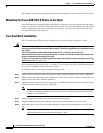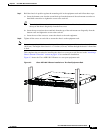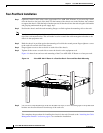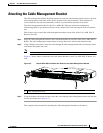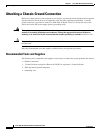
4-3
Cisco ASR 1001-X Router Hardware Installation Guide
OL-32376-02
Chapter 4 Cisco ASR 1001-X Router Installation
General Guidelines for Rack Installation
Note Ensure that the cable-management U feature device has the open end pointing outwards when
you attach it to the chassis.
Step 7 Gather the two cable-management brackets and screws shipped with your chassis. See the “Attaching the
Cable Management Bracket” section on page 4-9.
Step 8 Screw a cable-management bracket to each side of the rack-mount brackets that are attached to the
chassis. Use two screws for each cable-management bracket. Use a screw from the package of four
screws.
Step 9 Check that all the screws are securely tightened.
Step 10 Go to the “Attaching a Chassis Ground Connection” section on page 4-10 for instructions about
continuing the installation.
General Guidelines for Rack Installation
When planning your rack installation, consider the following guidelines:
• The Cisco ASR 1001-X Router requires a minimum of 3.5 inches or 8.9 cm rack units of vertical
rack space. Measure the proposed rack location before mounting the chassis in the rack.
• Before using a particular rack, check for obstructions (such as a power strip) that could impair
rack-mount installation. If a power strip does impair a rack-mount installation, remove the power
strip before installing the chassis, and then replace it after the chassis is installed.
• Allow sufficient clearance around the rack for maintenance. If the rack is mobile, you can push it
back near a wall or cabinet for normal operation and pull it out for maintenance (installing or moving
cards, connecting cables, or replacing or upgrading components). Otherwise, allow 19 inches (48.3
cm) of clearance to remove field-replaceable units.
• Maintain a minimum clearance of 3 inches on the front and back sides of the chassis for the cooling
air inlet and exhaust ports, respectively. Avoid placing the chassis in an overly congested rack or
directly next to another equipment rack; the heated exhaust air from other equipment can enter the
inlet air vents and cause an overtemperature condition inside the router.
Caution To prevent chassis overheating, never install a Cisco ASR 1001-X Router in an enclosed space that is
not properly ventilated or air conditioned.
• Always install heavier equipment in the lower half of a rack to maintain a low center of gravity to
prevent the rack from falling over.
• Install and use the cable-management brackets included with the Cisco ASR 1001-X Router to keep
cables organized and out of the way of the cards and processors. Ensure that cables from other
equipment already installed in the rack do not impair access to the cards or require you to disconnect
cables unnecessarily to perform equipment maintenance or upgrades.
• Provide an adequate chassis ground (earth) connection for your router chassis.
In addition to the preceding guidelines, review the precautions for avoiding excessive temperature
conditions in the “Physical Characteristics” section on page 3-10 and the “Site Environmental
Requirements” section on page 3-9.



